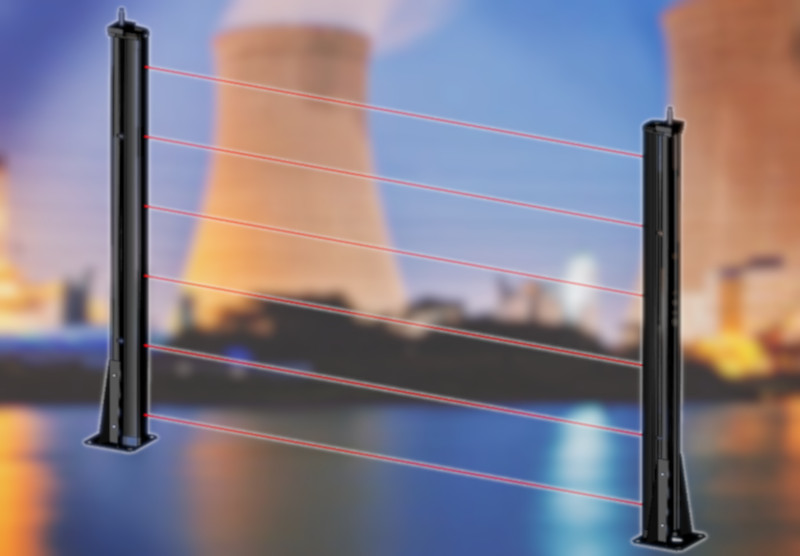Hard-wired Commercial Grade Active IR Barrier
EASY INSTALLATION : Alarm contact outputs on each column, integrated alignment aid tool in every column allows for one person set-up and alignment
RELIABILITY : Synchronized multiplexed beams, three detection modes: mono (single) beam detection, dual adjacent beam detection and temporized mono-detection (for bottom beam to detect crawling)
INNOVATION : The only commercially available IR beam on the market with transmitter and receiver in one column (Dual Interlaced Scanning (D.I.S.) technology)
ADAPTABILITY : Can adjust for different levels of terrain; beam height can be adjusted to fit site; integrates into existing environment – i.e. wall mounting, control panel network card can be integrated into column
Overview
Based on the 100Hz D.I.S. patented technology platform of integrating the transmitter and receiver functions in a single column, the MIRIS 3100 creates a true infrared invisible wall.
The MIRIS 3100 infrared beams can be set to single or dual detection mode. Breaking two adjacent beams eliminates the dead zone typical in standard infrared barriers.
Mono-beam detection allows for an increased level of protection whereby the lower beam can be set to time-delayed mono-detection mode in order to detect intrusions caused by crawling (advanced configuration by computer).
Installation is simplified by having contact outputs on each of the MIRIS 3100 towers, reducing the amount of wiring required.
| MIRIS 3100 | |
| Maximum range outside | 656 feet (200 m) |
| Available tower heights | 6.5 ft. (2m) - 10 ft. (3m) |
| Alarm output per tower | Intrusion - Disqualification - Tamper - Anti-climbing Dry contact relays NC with alarm status off; 30 VDC, 1A |
| Alarms produced | Intrusion, disqualification, Tamper and Anti-climbing |
| Power supply | 24/48VDC, optional 12VDC 1.2Ah battery backup |
| Alignment aid tools | Audible and visual signals on all the towers |
| Operating Temperature | -40°F to +158°F (-40°C to +70°C) |
| Number of cells per direction | 4, 6 or 8 cells |
| Cell management mode | Multiplexed and synchronized through optical link (4 channels) |
| Heater | Anti-frost thermostat heater inside each tower |
MONITORED AREA STATUS AND MAINTENANCE
To ensure optimal performance of the MIRIS 3100, the following environmental conditions should exist:
- Vegetation: the area between the infrared columns must be free from any obstacles. This requires grass cutting and tree trimming around the area.
- Cover Cleaning: Cleanliness of column covers should be checked regularly and at minimum cleaned annually with a soft, damp cloth.
- Site terrain: Check that ground is level and will ensure the stability of the columns over time. A maximum of 10° elevation may be tolerated between the columns. In case of elevation above 10°, contact PROTECH’s sales department.
ADDITIONAL FENCING
A perimeter fence may be recommended to optimize the installation. In this scenario, the infrared barrier must be placed at least 6.5 feet (2 m) away from the fence and be the same height as the fence.
If the 6.5 ft. (2 m) distance is not possible, the infrared column must be a minimum of 1.6 feet (0.5m) higher than the fence. For high security sites, the IR column should be at least 3 feet (1 m) higher than the fence.
Infrared technology operates at a wavelength above that of visible light (940nm), which makes the IR beam invisible to the naked eye. New improved IR cells extends your range to 656 feet (200m). The cells are backwards compatible with the 100m NCIS cells. The LASER cells are product safety classified as Safety Standard class 1 of IEC60825-1 and CFR Part1040.10. Class 1 lasers are considered safe under all normal operating conditions and are not expected to exceed the maximum permissible exposure (MPE).
IR beams are transmitted and received by infrared cells – transmitter cells generate and send a pulsed beam to the receiver cells which capture infrared pulses and turn them into electrical signals. When an absence, loss or change in the signal occurs (loss of 95% of the transmitted signal), an intrusion alarm is triggered. To prevent interference of receiver cells by the infrared beams being transmitted, cells are multiplexed.
Multiplexing is a principal whereby infrared pulses are transmitted in a synchronized manner by an optical or wired link between transmitter and receiver columns. This feature optimizes cell alignment (“alignment feedback”). All the PROTECH IR barriers are multiplexed.




